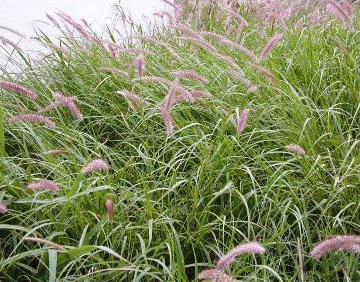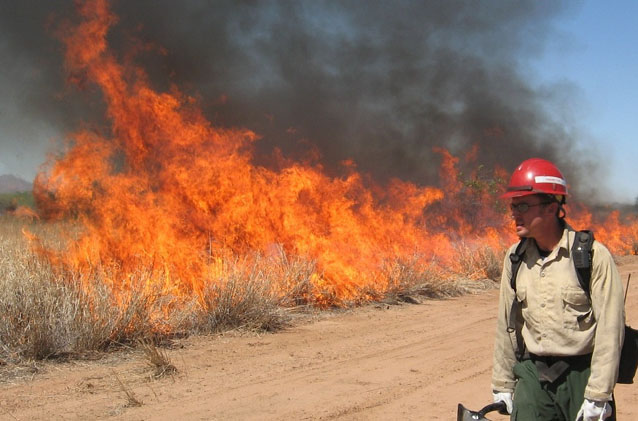Saguaro National Park is located in the Sonoran Desert. Visitors from around the world are drawn to the park’s iconic southwestern landscape, characterized by a wide diversity of plants and animals, including the giant saguaro cactus. Today, this desert is increasingly threatened by buffelgrass, a perennial invasive grass native to Africa.
Background

Buffelgrass (Pennisetum ciliare) was introduced to the Southwest for cattle forage and erosion control beginning in the 1940s. Plantings occurred throughout Arizona. It is now spreading rapidly across the Sonoran Desert. This plant poses an immediate threat to the ecosystem. Invasive buffelgrass alters natural ecological processes, competes with and excludes native plants, and alters wildlife habitat. Most importantly, it increases the frequency of wildfires.
Fires are historically rare in the Sonoran Desert, burning about once every 250 years. The wide spaces between plants make it difficult for fire to spread. Invasive plants, such as buffelgrass, fill in the spaces between native plants, exponentially increasing fire danger. Desert fires can harm habitat and kill saguaros and other natives not adapted to fire.
Buffelgrass and the ensuing threat of fire are a major concern for Saguaro National Park and other public land management agencies. There are an estimated 2,000 acres of buffelgrass in the park, and it can double every three to seven years. Over time, infestations grow in size and density. Many scientists think that with continued buffelgrass expansion, local extinctions of saguaros and many other native species may occur, changing the Sonoran Desert and wildlife forever.
Buffelgrass and Fire
Buffelgrass has the potential to introduce frequent and intense fire into the desert, with potentially catastrophic consequences. Such fires also pose a threat to public safety, homes, and infrastructure.
In 2008, as part of a a cooperative research project with the University of Arizona, Saguaro National Park, and the City of Tucson, 160 acres of buffelgrass were subjected to a prescribed burn. The following results tell us that a buffelgrass fire will result in unprecedented fire behavior in the Sonoran Desert:
- Buffelgrass fuel loads in the Sonoran Desert can range from 1 to 4 tons per acre. This is 2 to 4,000 times greater than historic levels of fuel loading. Because of this heavier fuel load, the desert can burn under a wider range of weather conditions.
- Peak fire temperatures in the experimental burn were between 1,300 and 1,600°F--hot enough to melt aluminum. These temperatures are 2-8 times hotter than fire temperatures of earlier fires that were fueled by annual plants.
- Flame lengths were 12-18 feet under relatively mild conditions. Under more extreme conditions, flame lengths will exceed 25 feet. A buffelgrass fire’s flame lengths are predicted to be 4-9 times taller than observed in previous desert fires.
- Rate of fire spread in buffelgrass has been measured at about 2-3 miles per hour under moderate conditions. This is about 10 times faster than predicted for usual desert fuels.

Consequences

Previous desert fires have resulted in 20-80% mortality to saguaros. They have also killed other cactus species, paloverde, and fire-sensitive plants. Native-plant mortality from buffelgrass fires is expected to be much higher than that from historic fires because of high flame temperatures and prolonged residual burning. Taller flame lengths mean wider fuel breaks are needed to stop a fire, and firefighters will not be able to fight the fire with hand tools and backpack pumps. Buffelgrass can reduce property values in infested and increasingly fire-prone areas.
Tourism revenues, which are a vital part of the economy in southern Arizona, may be severely impacted because the unique and iconic saguaro-dominated landscape may be lost. The costs of invasive-plant control and firefighting for government agencies are already increasing, and are likely to reach unprecedented levels.
Research

Buffelgrass research at the park began in 2000. The first research project was designed to evaluate the effectiveness and costs of different control methods (hand pulling, mowing, and herbicides). Since then, the park staff has written numerous grants and received funding to conduct research on topics such as different types and rates of herbicides, timing of herbicide application, and the effect of herbicides on native vegetation.
Other research includes modeling to predict buffelgrass spread; use of satellite data and aerial photography to detect and monitor buffelgrass, biomass and fuel load; and buffelgrass fire behavior. Current research projects include the effect of buffelgrass on desert tortoise, spot herbicide application using a helicopter, and techniques for restoring native vegetation after a fire or after buffelgrass removal.
Treatment History

Buffelgrass was first recorded in Saguaro National Park in 1989, but it was not recognized as a threat until the early 1990s. In 1993, staff and volunteers began pulling buffelgrass by hand. Manual removal is labor-intensive, and buffelgrass spreads faster than it can be controlled by hand-pulling or using backpack sprayers for herbicide application.
From 2002 to 2004, park managers evaluated the cost and efficacy of different control techniques and developed an Environmental Assessment and Exotic Plant Management Plan (2004). The plan embraced integrated pest management applications, including the use of herbicides. Herbicides with the active ingredient glyphosate are highly effective at killing buffelgrass.
Unfortunately, this herbicide is only effective when the plant is green (usually during summer monsoons and sometimes in late winter or early spring). When the grass is dormant, park staff and volunteers remove it by hand.
Treatments need to occur year-round for at least 3-5 years because viable seed remains in the soil. Previously treated areas need to be monitored regularly to ensure new plants have not established.

Successes

Despite the challenges of buffelgrass control, Saguaro National Park is encouraged by the progress and successes seen over the past several years. Community support, awareness, education, outreach, and a strong volunteer effort have contributed to the successes.
More Information

Perry Grissom
Frankie Foley, Biologist
phone: (520) 733-5179
email: sagu_invasive@nps.gov
Saguaro National Park
3693 S. Old Spanish Trail
Tucson, AZ 85730
Prepared by Saguaro National Park, 2011.
Last updated: November 28, 2016
